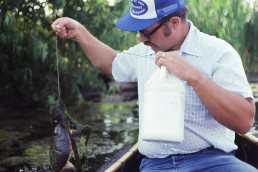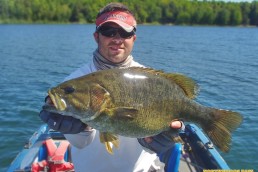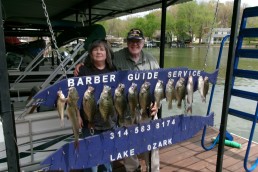Easy to Catch, Tasty on the Table, Snapping Turtles Abound
SHARE THIS POST
Have you ever seen a snapping turtle in its natural habitat? Most outdoorsmen haven’t. Over a long and checkered career I’ve seen maybe a dozen, two under winter ice, one crossing a road, another plodding across a plowed field and the rest spotted at dawn or dusk, usually in creeks and rivers. “Out of sight, out of mind” fits the snapper well, and there are many pond and lake owners who have lots of these nocturnal creatures, and no idea that any are around.
There are signs if you look: claw prints along muddy shores, droppings not of muskrat origin on rocks, dead fish that turn up missing and baby ducklings that diminish from eight or so down to nothing. Snappers spend their days holed up beneath cutbanks, in muskrat holes or buried back beneath thick vegetation, then come out at night to patrol the shores and open water seeking bullfrogs, fish or anything else living or dead that is remotely edible. These big reptiles are slow and secretive, but very strong and more than willing to fight—their hissing and snapping is how they got their name.
It’s a good idea to thin out or eliminate such turtles from a favorite pond or lake, occasionally. Doing so won’t keep them out indefinitely, since the animals move occasionally, seeking new waters, but it may at least keep them under control while providing you with some good eating in process.
Getting rid of them is easy. In farm ponds, I use one-gallon plastic jugs with about 4 feet of heavy trotline cord and a thick, heavy-duty hook. Bait is sometimes tough, old woodchuck meat, chunks of neck beef or even pieces of bluegills caught in the same pond. I place the rigs along the shore in late evening, often with the jug on dry land and the bait in just a few inches of water or half submerged on a rock. Questing turtles find the bait, swallow the hook, and drag the highly visible jug back to their daytime layup places—they are easy to find.
Are you enjoying this post?
You can be among the first to get the latest info on where to go, what to use and how to use it!
I’ve made sets in creeks and small rivers too, and you’d be surprised at how many snappers even a thin-water, little creek can hold. Once I made some sets on a creek I could wade across without getting my ankles wet, placing lines on willows overhanging shady pools and dangling the baits just above the surface. In one l00-yard stretch, I took four of up to 15 pounds. Do keep in mind that snapping turtles can be hunted only from July 1 to April 30 of the following year, and must have a straight-line carapace length of 13 inches or greater to be taken, but there’s no daily limit.
Cleaning the animal has always been the hard part for me, and I’ll freely admit that I hate it. First, carefully place one foot on the shell and stretch the neck with your hook and trotline cord, and then cut or chop off the head. Let it drain for a while, and then dip the carcass in boiling water to remove any leeches, algae, etc. Next, remove the shell by cutting between each pair of side legs with a hatchet, tin snips, or whatever, and cut off the four legs and neck. Remove the tail if it’s a big turtle, and skin and remove all the fat, which has a bad flavor.
After that, it’s it up to you. Many fry the sections like chicken, and turtle is excellent when cooked this way. Others like to make turtle soup by dropping pieces into simmering potatoes, onions, carrots, and celery and adding whatever seasonings they favor. Either way, turtle is very tasty and worth the catching and the cleaning.
MWO
SHARE THIS POST
Did you enjoy this post?
You can be among the first to get the latest info on where to go, what to use and how to use it!
Richard Martin
Dick Martin is a retired biology teacher with a bachelor’s degree in Biology from Ohio U. and a master’s degree in Zoology from Ohio State U. He is a longtime member of Outdoor Writers of Ohio and Outdoor Writers Association of America. He and has written many outdoor articles on a variety of subjects.




